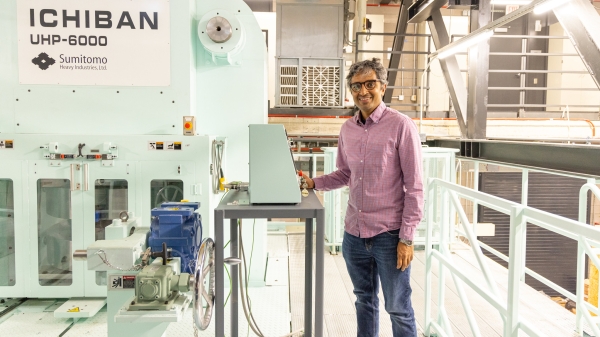Pushing beyond the standard: ASU physics student awarded national fellowship

Glenn Randall was awarded the opportunity to perform high-precision neutron research at the Oak Ridge National Laboratory.
Arizona State University graduate student Glenn Randall was recently awarded a research fellowship to the Oak Ridge National Laboratory (ORNL).
The Department of Energy Office of Science Graduate Student Research Program selected Randall as one of 47 graduate students to be awarded the opportunity to pursue part of their graduate thesis research at a Department of Energy laboratory. The labs operate in various areas of focus pertaining to the Office of Science’s mission to “…transform our understanding of nature and to advance the energy, economic and national security of the United States.”
Randall will be collaborating with Leah Broussard at ORNL in the area of low energy physics.
As scientists continue to explore the universe and its components, the invention of experiments and testing instruments of greater and greater accuracy bring new perspective and provide new insight into the makeup and interaction of particles.
In this quest for discovery, Randall and Broussard will be conducting a high-precision measurement of two different neutron beta decay parameters. This decay interaction is referred to as weak force and is instrumental in obtaining a better understanding of the sun and its fusion power.
Based on what is understood so far, one of the parameters of the experiment should be zero. However, with new equipment that allows for finer accuracy, there is a new chance to determine whether the standard model of zero holds, or whether a newer calculation that was previously too small to be measured is discovered.
The standard model describes the whole of what is currently known about nuclear and particle physics in the universe — and it has held up for close to 50 years. However, despite its continued accuracy in ongoing tests, there remain some mysteries. The discovery of a new measurement that disagrees with the standard model would spark valuable new discussions and open the door for other important discoveries.
The second parameter being considered in Randall’s research with Broussard will take a closer look at differing measurements shaping our current understanding of how weak nuclear force interacts, particularly with quarks, a type of elementary particle.
Varying methods to arrive at these measurements are highly sensitive and depend on a different combination of theoretical principles. Comparing these new results to others will provide new hints and insight.
“Everything needs to be very high precision,” Randall said. Even the smallest error has the potential to throw everything off.
As is so often the case in physics, careful examination of incredibly small elements lend a broader understanding of the universe as a whole. Through these careful and exceptionally precise measurements of neutrons and their interaction — the weak force — results have the potential to push past the standard model of understanding and push us into the realm of new physics, new theories and ideas for what is out there and how it works.
This possibility of discovering answers to questions that still leave us in the dark is one of the things that kept Randall on his path to studying physics.
Despite attending a high school with a very small program — physics classes were only offered every other year — he felt that physics just made sense, and he took advantage of every opportunity to learn more.
“I like to think that given enough time, we will find ways to improve the lives of humanity through physics,” he said.

Randall completed his undergraduate degree at Dartmouth College in Hanover, New Hampshire. He knew he would go on to a graduate program in physics eventually, but he felt the push to see what he could accomplish in his other passion: athletics. After graduating, he took a few years off to pursue professional running and skiing.
Once he determined it was time to continue academically, the consideration of several factors led him to ASU, including the warm weather and the Department of Physics’ faculty graduate advisers.
“I’ve always had the belief that the really important thing is who your adviser is,” he said.
Randall has been studying under Physics President’s Professor Ricardo Alarcon, whose extensive research includes fundamental symmetries of nature, specifically relating to the neutron. He is also involved in experiments looking at precision measurements of electron scattering.
More Science and technology

Securing the wireless spectrum
The number of devices using wireless communications networks for telephone calls, texting, data and more has grown from 336…

New interactive game educates children on heat safety
Ask A Biologist, a long-running K–12 educational outreach effort by the School of Life Sciences at Arizona State University, has…

Unlocking Earth's origins
Looking up at a vast, star-studded sky, people have always wondered: Are we alone in this universe? It’s a fundamental question…